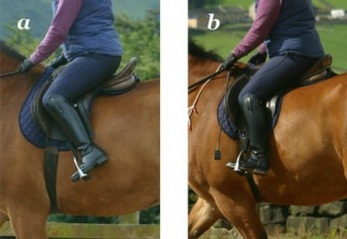As a horse rider do you wish you had longer legs?
Aug 24, 2021
Why do so many people who ride wish they had longer legs?
Almost everyone who rides horses wishes they had longer legs. But usually for the wrong reasons. Longer legs tend to look more elegant, but much more importantly, they can make you more secure. Not because you can then grip better with them, no, (you should not grip when riding), but because they lower your centre of gravity (make sure you also read this article - www.equiculture.net/blog/hrm-how-to-get-in-touch-with-your-centre-of-gravity
Of course, you do not get to have the option of longer legs, so, even though you cannot grow longer legs, you can make the best of what you have.
Making the best of what you have can mean the difference between unplanned dismounts ('hitting the deck') and riding through a potential calamity like a boss. Maybe even while simultaneously making some of your more spindly long-legged friends envious.
How to make the best of what you have when riding
It is usually possible to vastly improve how your legs 'behave' when riding, avoiding those 'legs behaving badly' moments. It is all about getting your centre of gravity down low, maintaining the correct pressure wth your stirrups, 'engaging' your lower legs properly etc.
Why should your stirrups be the correct length when riding?
This does not mean having them longer than they should be to create the illusion of longer legs. It doesn't work like that. If your stirrups are too long, then all sorts of things go wrong - sometimes severely wrong. Read this blog post about how to achieve the correct stirrup length - www.equiculture.net/blog/hrm-your-stirrup-length-what-is-just-right
Why must you have the correct pressure on your stirrups when riding?
This is not something you will hear about very often. If you do not weight your stirrups correctly, your stirrups will rattle around on your feet. Then you will start to grip with your knees. Then your legs will begin to shrivel and curl up your horse's sides like strips of orange peel left out in the sun.
If you can weight your stirrups correctly, your legs will always stay down your horse's sides. Achieving this superpower means learning how to engage your lower legs properly.
Why must you learn to engage your lower legs when riding?
This is another point that you won't hear about very often. But it is probably the most critical thing you should learn about as a rider.
Having engaged lower legs means that you are more likely to stay on your horse when you are at a competition, and a helicopter lands in the next field, and your friends/peers are flying off like ping pong balls in a lottery machine. It means your legs are staying long (as long as possible) down your horse's sides, where they are intended to be. Especially in a crisis. Priceless.

Disengaged lower leg (a) and engaged lower leg (b)
How do you achieve all this at the same time?
After getting your stirrup length correct, you practice, practice, practice.
By carrying out specific exercises designed to get you weighting your stirrups correctly and engaging your lower legs properly, you will learn how to keep your legs down each side of your horse. These exercises involve such activities as standing in your stirrups while keeping your centre of gravity low at the same time. In walk at first but working up to trotting. It is hard to do initially, but wow, is it effective!
Take it easy, especially at first. Get yourself a neckstrap to hold on to, and start by standing in your stirrups at a standstill. Let your heels drop just below your toes (but no more). Then work up to walking and eventually trotting. Take frequent breaks. This exercise stretches your calves, but most importantly, it gets you to weight those stirrups properly and engages your lower legs.
Eventually, you will be able to keep your legs under you in almost any situation.
And your legs will look as long as possible. But who needs long legs when you can have effective, engaged legs?
Learning about how to keep your lower legs ‘engaged’ underneath you, improving the stability of your lower legs, and improving your position and balance are at the heart of The Horse Rider’s Mechanic books and Horse Rider's Mechanic online course
How can you learn more about rider biomechanics?
Sign up for this FREE 23-page PDF checklist 10 Common Position and Balance Checks for Riders. Start learning how to be the best rider you can be.


















